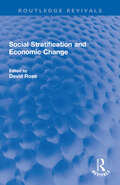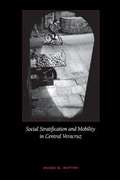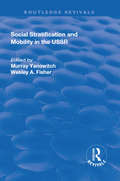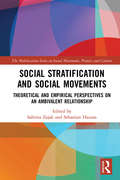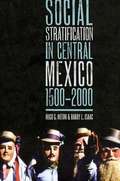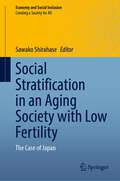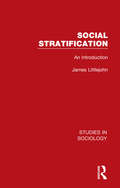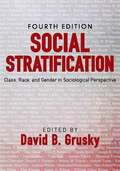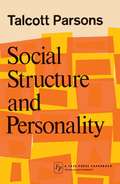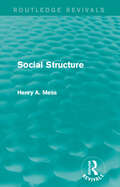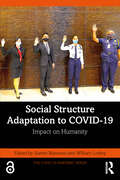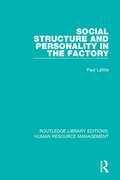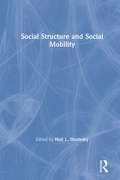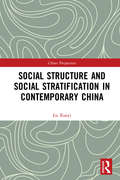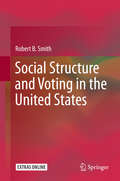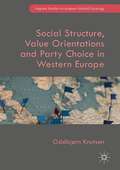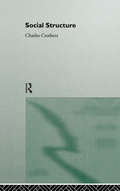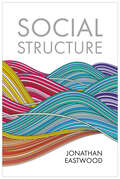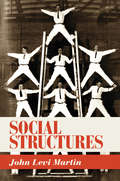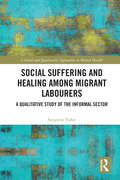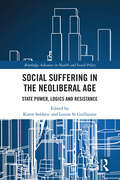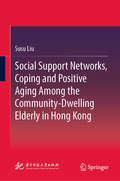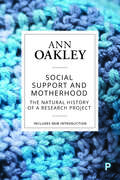- Table View
- List View
Social Stratification and Economic Change (Routledge Revivals)
by David RoseFirst published in 1988, Social Stratification and Economic Change brings together, for the first time in textbook form, some of the most significant work both theoretical and empirical on stratification in Britain. In part I, David Rose provides on overview of stratification research, and papers from David Lockwood, John Goldthorpe, Gordon Marshall, Ray Pahl, and Claire Wallace tackle key theoretical issues. In part II, six papers commissioned for the book report on empirical studies and their implications. By bringing together an outstanding group of authors, all at the forefront of their field, the book makes an important contribution to debates on social stratification and will be invaluable for both students and researchers in sociology.
Social Stratification and Mobility in Central Veracruz
by Hugo G. NutiniSince the Revolution of 1910, Mexican society has undergone a profound transformation, characterized by the disempowerment of the landed aristocracy and the rise of a new ruling class of plutocrats and politicians; the development of a middle class of white-collar professionals; and the upward mobility of formerly disenfranchised Indians who have become urban, working-class Mestizos. Indeed, Mexico's class system today increasingly resembles that of Western industrialized nations, proving that, while further democratic reforms are needed, the Revolution initiated an ongoing process of change that has created a more egalitarian society in Mexico with greater opportunities for social advancement.
Social Stratification and Moblity in the USSR
by Murray Yanowitch and Wesley A. FisherThis title was first published in 1973. The selections from Soviet sociological literature presented in this volume are significant from at least three standpoints. First, they reveal the extent to which the issue of social and economic inequality has become a subject for legitimate public discussion in the Soviet Union. Second, these selections offer the reader a means of appraising the quality of work in what, under Soviet conditions, is the formative period of a new intellectual discipline. Third, the selections provide abundant empirical evidence bearing on the forms and degrees of inequality currently found in Soviet society.
Social Stratification and Social Movements: Theoretical and Empirical Perspectives on an Ambivalent Relationship (The Mobilization Series on Social Movements, Protest, and Culture)
by Sebastian Haunss Sabrina ZajakThis volume addresses the contested relationship between social stratification and social movements in three different ways: First, the authors address the relationship between social stratification and the emergence of protest mobilization. Second, the texts look at social stratification and social positions to explain variations in political orientations, as well as differing aims and interests of protestors. Finally, the volume focuses on the socio-structural composition of protestors. Social Stratification and Social Movements takes up recent attempts to reconnect research on these two fields. Instead of calling for a return of a class perspective or abandoning the classical social movement research agenda, it introduces a multi-dimensional perspective on stratification and social movements and broadens the view by extending the empirical analysis beyond Europe.
Social Stratification in Central Europe: Long-term Developments and New Issues (SpringerBriefs in Sociology)
by Jiří VečerníkThis book provides a comparative and contemporary account of social stratification in the Central European states of Czechia, Poland, Hungary, and Slovakia (the Visegrad Four – V4 group), and also by contrast with Austria. It looks at the shared history of these countries as part of the erstwhile Austro-Hungarian Empire. While the V4 states experienced, for decades, the regressive authoritarian Soviet rule, Austria escaped this fate. The question is how some common historical roots, impact of the communist regime, and transition paths have shaped the specific social structures of V4 countries which differ despite belonging to a relatively homogeneous region. The book examines the changes and developments through analyses of large comparative surveys and other data collected after 1990, most notably using the European Union’s survey “Statistics on Income and Living Conditions” (EU-SILC) that has been fielded since 2005. The book starts with an outline of the long-term developments in key social structure dimensions which occurred during the post-communist transition. The analytical chapters then discuss topics previously not much examined in social stratification perspective: subjective well-being, couples’ status, cultural activities and differences among retirees. This book is intended for social scientists working on stratification research, and, specifically, V4 societies and politics.
Social Stratification in Central Mexico, 1500-2000
by Hugo G. Nutini Barry L. IsaacIn Aztec and colonial Central Mexico, every individual was destined for lifelong placement in a legally defined social stratum or estate. Social mobility became possible after independence from Spain in 1821 and increased after the 1910-1920 Revolution. By 2000, the landed aristocracy that was for long Mexico's ruling class had been replaced by a plutocracy whose wealth derives from manufacturing, commerce, and finance--but rapid growth of the urban lower classes reveals the failure of the Mexican Revolution and subsequent agrarian reform to produce a middle-class majority. These evolutionary changes in Mexico's class system form the subject of Social Stratification in Central Mexico, 1500-2000, the first long-term, comprehensive overview of social stratification from the eve of the Spanish Conquest to the end of the twentieth century. The book is divided into two parts. Part One concerns the period from the Spanish Conquest of 1521 to the Revolution of 1910. The authors depict the main features of the estate system that existed both before and after the Spanish Conquest, the nature of stratification on the haciendas that dominated the countryside for roughly four centuries, and the importance of race and ethnicity in both the estate system and the class structures that accompanied and followed it. Part Two portrays the class structure of the post-revolutionary period (1920 onward), emphasizing the demise of the landed aristocracy, the formation of new upper and middle classes, the explosive growth of the urban lower classes, and the final phase of the Indian-mestizo transition in the countryside.
Social Stratification in an Aging Society with Low Fertility: The Case of Japan (Economy and Social Inclusion)
by Sawako ShirahaseThis edited book empirically discusses stratification in contemporary Japanese society. It is unique for its examination of social inequality in relation to declining fertility and an aging population. Japan is the most aged society in the world: according to the Statistics Bureau of Japan, people who are aged 65 and above comprised 29.1% of the country’s total population in 2021. Meanwhile, the fertility rate has continuously declined since the mid-1970s. Japan experienced a dramatic change in its demographic structure in a short period of time. Such fast change could be a major factor that generated social stratification. In her industrialization, Japan was thought to share a pattern of social stratification similar to that of developed European and North American countries but with a low degree of socio-economic inequality and a high degree of homogeneity. There is no clear support for this description of Japan, although the country does share a pattern and degree of social stratification similar to that observed in Europe and North America. The social stratification theory has been developed in close relationship to the labor market; however, it is necessary to further examine the social stratification of very aged societies in which a substantial number of the population—namely, retired persons—no longer have any ties to the labor market. In this book, the contributors explore the pattern of social stratification at three life stages: young, middle-aged, and elderly. Included are discussions of various aspects of stratification such as education, work, wealth, marriage, family, gender, generation, and social attitudes.
Social Stratification: An Introduction (Studies in Sociology)
by James LittlejohnOriginally published in 1972, this book aimed to provide the student with a basic understanding of the main theories of social stratification and to acquaint them with current methods of research, with the results from modern research (with emphasis on British research), and with current issues in this field. The first two chapters are concerned with theory and are followed by chapters on slavery and the caste system. These are intended to illustrate concepts and theory and to offer the student a comparative perspective in which to view stratification in modern society – which is dealt with in a final lengthy chapter. The book has been written primarily for first-year university students, but also with sixth-formers and students in colleges of further education in mind.
Social Stratification: Class, Race, and Gender in Sociological Perspective, Fourth Edition
by David B. Grusky Katherine R. WeisshaarThe fourth edition includes fifty new or updated readings and a new streamlined organization that allows the evolution of stratification scholarship to unfold in a systematic fashion. The new readings cover the latest research on economic inequality, including the social construction of racial categories, the new immigrant economy, new forms of segregation and neighborhood inequality, the uneven and stalled gender revolution, the role of new educational forms and institutions in generating both equality and inequality, and the extent of anti-gay discrimination in the labor market.
Social Structure & Person
by Talcott ParsonsA Collection of essays which studies the theoretical problem of relationships between social structure and personality, and how these different relationships merit distinct treatment for particular purposes. Parsons concludes that in the larger picture, their interdependencies are so intimate that bringing them together in an interpretive synthesis is imperative if a balanced understanding of the complex as a whole is to be attained.
Social Structure (Routledge Revivals)
by Henry A. MessOriginally published in 1942, during the Second World War and a time of great social and economic upheaval, Henry A. Mess endeavours to give a succinct account of the main elements in social structure and of their interrelations. He offers discussions on such broad topics as human nature, the role institutions play in society, and warfare as a universal feature of societies. This title is a short and accessible introduction to sociology and will be of value to students interested in the subject.
Social Structure Adaptation to COVID-19: Impact on Humanity (The COVID-19 Pandemic Series)
by Suresh Nanwani William LoxleySocial Structure Adaptation to COVID-19 offers global, interdisciplinary perspectives that examine how the COVID-19 pandemic has altered the development trajectory of schools, public health, the workforce, and technology adoption. It explores social themes in society, economy, policy, and culture and draws on a social framework to describe key functions of societal adaptation to the pandemic.Edited by Suresh Nanwani and William Loxley, the volume is grounded in the study of system components and their objectives to improve overall well-being given the ill effects of the COVID-19 pandemic. Chapters explore interconnected social networks and how sectors restructured themselves to stabilize or transform society. International contributors from 20 countries offer case studies that highlight key themes including personal connectivity, societal equality, well-being, big data, and national resilience. They predict how impactful the pandemic might be in reshaping the future and assess how the COVID-19 pandemic has affected school system shutdown, public health collapse, business closures, public policy failure, and technology-driven social media acceleration.Offering insights into how institutions and sectors work together in times of crisis, and how COVID-19 has restructured social behavior, Social Structure Adaptation to COVID-19 will be valuable reading for scholars and students of sociology, political science, anthropology, comparative international development, psychology, and education. It will also be of interest to policymakers concerned with education, work and organizations, and media and technology.The Open Access version of this book, available at www.taylorfrancis.com, has been made available under a Creative Commons Attribution-Non Commercial-No Derivatives (CC-BY-NC-ND) 4.0 international license.
Social Structure and Personality in the Factory (Routledge Library Editions: Human Resource Management #23)
by Paul LafitteThis study, first published in 1958, explores the behaviour of industrial workers in a social context. By interviewing and observing workers in factories in Melbourne, the author examines the worker’s evaluation of work, work satisfaction, relationships and friendships within the workplace, and the worker’s place in society. This title will be of interest to students of psychology, sociology and business studies.
Social Structure and Social Mobility
by Neil Larry ShumskyFirst Published in 1996. Volume 7 SOCIAL STRUCTURE AND SOCIAL MOBILITY of the ‘American Cities; series. This collection brings together more than 200 scholarly articles pertaining to the history and development of urban life in the United States during the past two centuries. Volume 7 looks at social class structure and social mobility. Its articles address questions that have intrigued historians for decades. What has been the class structure of American cities during the past two centuries? How much mobility has been possible? For whom has it been possible? What has been the relationship between social and geographic mobility? Finally, how have all kinds of Americans tried to improve their social status?
Social Structure and Social Stratification in Contemporary China: Vol. 1 (China Perspectives)
by Xueyi LuWhat is the social structure of Chinese society in the 21st century? How should China address the problem of migrant workers? How can China form a modern society? These key sociological issues are some of the topics this book covers.This book is a collection of the research articles and lectures that Dr. Lu Xueyi, the former Head of the Institute of Sociology at the Chinese Academy of Social Sciences, has published since the 1980s. The author discusses the social structure, social stratification, social construction, and development of contemporary Chinese society. Arguing that the gap between economic and social development has become the major social issue facing modern China, the author advocates paying close attention to the country’s social structure and the growth of the middle class.The book will be of interest for all scholars and students of Sociology and Chinese Studies.
Social Structure and Voting in the United States
by Robert B. SmithThis bookanalyzes practical and moral influences on voting decisions. Undermining the widespreadassumption that economic self-interest is the key determinant of voting choices,it discovers that moral considerations rooted in religious traditions are oftenthe more decisive. This finding is confirmed through a close analysis oftangible problems, such as child neglect and crime, problems which one wouldexpect to trouble practical voters. Further, this book suggests that politicalideologies influence party affiliation, rather than the other way around. It definesfour categories of states in terms of human development and income equality--South,Heartland, postindustrial, and "balanced. " It then explains why politicalcolor (red, purple, or blue) and societal problems vary across thesecategories. Voters' moral ideologies, itshows, combine with a state's measure of income equality and human development toshape a state's readiness to pursue practical solutions to societal problems. Finally, it shows that moral ideologiesof the religious right and authoritarianism, two very different concepts, are in fact intertwined empirically. This book thus suggests that education--a keydriver of human development, anti-authoritarianism, and deliberative voting--shouldbegin in preschools that are both nurturant and instructive.
Social Structure, Value Orientations and Party Choice in Western Europe (Palgrave Studies in European Political Sociology)
by Oddbjørn KnutsenThis book analyses the impact of socio-structural variables, such as social class, religion, urban/rural residence, age and gender, on influencing an individual’s voting preferences. There have been major changes in recent decades both to social structure and how social structure determines people’s voting behaviour. There has also been a shift in value orientations, for example from religious to secular values and from more authoritarian to libertarian values. The author addresses the questions: How do social structure and value orientations influence party choice in advanced industrial democracies?; To what extent is the impact of social structure on party choice transmitted via value orientations?; To what extent is the impact of value orientations on party choice causal effects when controlled for the prior structural variables? The book will be of use to advanced students and scholars in the fields of comparative politics, electoral politics and political sociology.
Social Structure: Recent Issues In Social Theory
by Charles CrothersCrothers's book provides a thorough introduction to the idea of social structure. He examines the meanings of the term, the history of its usage within sociology and looks at the more recent developments in thinking on social structure.
Social Structure: Relationships, Representations, and Rules
by Jonathan EastwoodSocial structure is arguably the central concept of sociology, and in recent years a much wider public has taken up with fresh vigor the sociological idea that persistent inequalities are rooted in social structures. Yet there seem to be as many definitions of the term as there are sociologists, and we often struggle to articulate accessible yet precise accounts of structures that can guide empirical research and other kinds of action. Jonathan Eastwood offers a set of pragmatic strategies for thinking about social structures, emphasizing ways in which we can approach them as complex lacings of relationships, representations, and rules. He then teases out a variety of implications of these strategies for qualitative and quantitative research, the analysis of social problems, and the implementation of social policies. Written for advanced undergraduate and graduate students as well as fellow scholars, this insightful book contributes to our understanding of this fundamental and dynamic ingredient of social life.
Social Structures
by John Levi MartinSocial Structures is a book that examines how structural forms spontaneously arise from social relationships. Offering major insights into the building blocks of social life, it identifies which locally emergent structures have the capacity to grow into larger ones and shows how structural tendencies associated with smaller structures shape and constrain patterns of larger structures. The book then investigates the role such structures have played in the emergence of the modern nation-state. Bringing together the latest findings in sociology, anthropology, political science, and history, John Levi Martin traces how sets of interpersonal relationships become ordered in different ways to form structures. He looks at a range of social structures, from smaller ones like families and street gangs to larger ones such as communes and, ultimately, nation-states. He finds that the relationships best suited to forming larger structures are those that thrive in conditions of inequality; that are incomplete and as sparse as possible, and thereby avoid the problem of completion in which interacting members are required to establish too many relationships; and that abhor transitivity rather than assuming it. Social Structures argues that these "patronage" relationships, which often serve as means of loose coordination in the absence of strong states, are nevertheless the scaffolding of the social structures most distinctive to the modern state, namely the command army and the political party.
Social Studies: Communities Around Us
by James B. Kracht Deborah Gray White Juan R. Garcia Daniel J. Gelo Linda L. GreenowThis book is built up on four themes viz., Learning About Communities, Different Kinds of Places, Communities Yesterday and Today, People and Citizenship. Also included are Maps, Time Line, Graphs, Tables, and Diagrams, Skills and Literature for optional reading.
Social Suffering and Healing among Migrant Labourers: A Qualitative Study of the Informal Sector (Critical and Qualitative Approaches to Mental Health Experiences among Vulnerable Groups)
by Sangeeta YadavThe book uncovers the nuances of the lives of unskilled migrant labourers in India. The qualitative approach, along with the social constructivist paradigm and ethnographic fieldwork demonstrates the nature of scientific inquiry carried out in this work. The data analysis methods supporting the narratives will not only help readers understand the experiences of the migrant communities but will also facilitate a bond of empathy with the participants.Taking a bottom-up approach, the book explores how migrant labourers’ suffering, and their sense of wellbeing are deeply embedded in their existing surroundings. It throws light on the numerous communities across the world that are at high risk of developing mental health related problems due to existing socio-political conditions.The book will be useful to the students, researchers, and teachers of Sociology, Social Work, Anthropology, Psychology, Political Science, Economics, Public Policy and Administration. It will be especially be useful to mental health professionals, social workers and NGOs engaging with migrant or other marginalized communities.
Social Suffering in the Neoliberal Age: State Power, Logics and Resistance
by Karen Soldatic Louise St GuillaumeThis book provides a rich synthesis of research and theory of nascent and emergent critically engaged work examining changing welfare structures, regimes and technologies and the social suffering that is generated in everyday lives. By rigorously examining social security restructuring with the turn to austerity governance and its daily practices of managing, regulating and subordinating individuals, peoples and communities, this collection delineates the machinery of state power and logics designed to manage, contain and control the lives of some of the most poorest and marginalized citizens who are reliant on social welfare income payments. A core strength of the book is first, its unpacking of austerity governance across diverse communities and, second, the elevation of community resistance and mobilization against the very measures of austerity. Combined, the work maps out the logics of state power and everyday practices of embedded contestation and confrontation. Using the case-study of Australia to discuss socio-legal re-categorisations, automation of welfare governance, technologies of policy design and delivery, conditionality and systems of penalisation, this book will be of interest to all scholars and students of sociology, critical theory, social policy, social work and disability studies, Indigenous studies and settler colonialism.
Social Support Networks, Coping and Positive Aging Among the Community-Dwelling Elderly in Hong Kong
by Susu LiuThe dramatically increasing aging population of Hong Kong has elicited new risks and opportunities to facilitate a positive life for older adults. This book offers a holistic review of gerontological theories and literature, and constructs a conceptual framework of social support networks, coping and positive aging. In light of the implications of the convoy model of social support to depict an indigenous landscape of positive aging in Hong Kong, this is one of the very few empirical studies that adopts both quantitative research and qualitative research. The research consisted of a pilot study of in-depth interviews with 16 older Hong Kong Chinese and a main study surveying 393 older members of District Elderly Community Center. The results of the study indicate that family and peer support constitute the mainstay of support networks of the elderly, and that family and peer support are associated with positive aging. Moreover, the study shows that it is the depth of emotional closeness, namely, close interaction and intimacy with social partners that makes the greatest contribution to positive aging. Additionally, problem coping and emotion coping are found to mediate the relationship between social support networks and positive aging. There is potential in bringing more domestic helpers into elderly care and improving the service quality such that the goal of Aging in Place can be promoted in Hong Kong. Intended for researchers in social work, gerontology and positive psychology, it is also essential reading for graduates and social work professionals interested in this area. This book makes a valuable contribution to social gerontological research among Hong Kong older adults and the promotion of wellbeing in the elderly via the construct of positive aging in the culture of Chinese society.
Social Support and Motherhood: The Natural History of a Research Project
by Ann OakleyDrawing on her long experience as an academic researcher and writer, Ann Oakley develops a sociology of the research process itself, telling the story of how a research project is undertaken and what happens during it, to both researchers and those who are researched. This remarkable book focuses on a topic of great importance in the provision of health services – caring and social support. Setting neglect of this topic in the wider context of an ongoing crisis in gendering knowledge, Social support and motherhood is now reissued for a contemporary audience. It has much resonance for social science researchers and others interested in the experiences of mothers, and in the relations between social research, academic knowledge and public policy.
